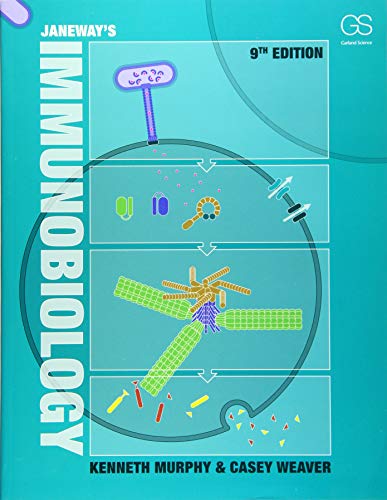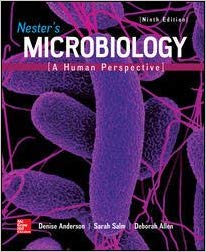Description
Test Bank For Immunobiology 9th Edition By by Kenneth Murphy
Janeway’s Immunobiology, 9th Edition
Chapter 5: The Generation of Lymphocyte Antigen Receptors
Primary immunoglobulin gene rearrangement
5-1 Immunoglobulin genes are rearranged in the progenitors of antibody-producing cells
5.1 Multiple choice: The exon encoding the V region of an immunoglobulin protein is generated by a process of somatic recombination. This recombination event brings V gene and J gene segments together:
A. In all cells of the body to encode a V region sequence
B. To generate maximum diversity in the CDR3 sequence of the V region
C. By alternative RNA splicing to encode a V region sequence
D. By a precise mechanism that never adds or loses nucleotides at the junction
E. To generate a single exon encoding the entire immunoglobulin protein
5-2 Complete genes that encode a variable region are generated by the somatic recombination of separate gene segments
5.2 True/False: Most eukaryotic genes are encoded in a set of exons that are brought together to form a contiguous protein coding sequence by the process of mRNA splicing. In contrast, immunoglobulin genes use somatic recombination of gene segments and not mRNA splicing to generate the final mRNA that is translated into protein.
5-3 Multiple contiguous V gene segments are present at each immunoglobulin locus
5.3 Multiple choice: Different individuals can have different numbers of functional V gene segments as well as different numbers of constant region genes. This type of genetic polymorphism between individuals indicates that:
A. The antibody heavy and light chain loci undergo more frequent mutation than other genes in the genome.
B. The recombination machinery is active in germ cells.
C. Individuals only need κ or λ light chains, but not both.
D. The precise number of antibody gene segments in an individual is not important.
E. Antibody gene segments underwent more frequent duplication during evolution than other genes in the genome.
5-4 Rearrangement of V, D, and J gene segments is guided by flanking DNA sequences
5.4 Multiple choice: Recombination signal sequences are conserved heptamer and nonamer sequences that flank the V, J, and D gene segments which undergo recombination to generate the final V region coding exon. Some of these have 12-nucleotide spacers between the heptamer and nonamer, and others have 23-nucleotide spacers. The reason recombination signal sequences come in these two forms is:
A. To ensure the correct assembly of gene segments so that a VH recombines to a DH and not to another VH, for instance
B. To ensure that the heptamer and nonamer are found on the same face of the DNA double helix
C. To ensure that κ, λ, and heavy chains recombine within a locus and not between loci
D. To ensure that κ, λ, and heavy chain gene segments do not undergo recombination with non-immunoglobulin genes
E. To ensure that the RAG recombinase cuts the DNA between the last nucleotide of the heptamer and the coding sequence
5-5 The reaction that recombines V, D, and J gene segments involves both lymphocyte-specific and ubiquitous DNA modifying enzymes
5.5 Figure Q5.5 shows the germ-line configuration of three V gene segments (#1, 2, 3), and two J gene segments (#4, 5). Which of the choices below represents a DNA configuration that would result from V-to-J recombination?
Figure Q5.5
5.6 Short answer: Most of the enzymes involved in immunoglobulin gene rearrangement are ubiquitously expressed in all cells of the body. However, the specific recombination events between V, J, and D gene segments that generate antibody diversity occur only in developing B cells. How do RAG-1 and RAG-2 ensure that recombination takes place at antibody gene segments?
5.7 Multiple choice: Antibodies that bind with high affinity to some viral surface proteins require heavy chain CDR3 loops of unusual length. Whereas the average human heavy chain CDR3 length is ~15 amino acids, antibodies with VH CDR3 loops of >30 amino acids are readily detected in the repertoire. These antibody heavy chains with CDR3 lengths of >30 amino acids would likely be missing in individuals lacking:
A. RAG-1 and RAG-2
B. DNA-dependent protein kinase (DNA-PK)
C. The nuclease, Artemis
D. The Ku70:Ku80 complex
E. Terminal deoxy nucleotidyl transferase (TdT)
5.8 True/False: When first discovered, investigators found it surprising that some single-gene defects causing immunodeficiency syndromes were associated with hypersensitivities to ionizing radiation, thereby leading to increased rates of cancer. The genes accounting for this dual impairment encode ubiquitously expressed DNA repair proteins.
5-6 The diversity of the immunoglobulin repertoire is generated by four main processes
5.9 Multiple choice: Antibody diversity is generated by multiple mechanisms, each of which contributes to the generation of antibodies with up to 1011 different amino acid sequences in their antigen-binding sites. Several of these mechanisms involve changes in the DNA sequences encoding the antibody heavy and light chain proteins. One mechanism that does not rely on changes to the DNA within the immunoglobulin heavy and light chain gene loci is, instead, dependent on:
A. The contributions of amino acids from both the heavy chain and the light chain to form the antigen-binding site
B. The random usage of V, D, and J gene segments to form the heavy chain V region sequence
C. The random usage of κ light chains versus λ light chains to pair with the heavy chain
D. The activity of TdT to add random nucleotides at the junctions between the V, J, and D region sequences
E. The fact that heavy chain V regions contain an extra gene segment encoded by the D region compared to light chain V regions
5-7 The multiple inherited gene segments are used in different combinations
5.10 Multiple choice: In rare instances, B cells can be found that have two immunoglobulin light chain alleles, both of which are rearranged in frame, and can encode functional light chain proteins. Yet, on the surface of the B cell, only one of the two light chain proteins is detected in the membrane-bound immunoglobulin receptor. The reason these rare cells have two functional light chain rearrangements but only express one of the two light chains as part of the B-cell receptor is:
A. One of the two light chains is formed from rearrangement of a V gene segment that is a pseudogene.
B. One of the two light chain proteins doesn’t form a stable complex with the heavy chain expressed in this cell.
C. One of the two light chain alleles is not transcribed efficiently, and produces only low levels of protein.
D. One of the two light chain alleles uses a V gene segment that is not targeted very often by the RAG recombinase.
E. One of the two light chains is rapidly degraded after synthesis due to improper folding.
5-8 Variable addition and subtraction of nucleotides at the junctions between gene segments contributes to the diversity of [Qi] the third hypervariable region
5.11 Short answer: An important mechanism for generating diversity in immunoglobulin light chain V-region sequences is based on the fact that the RAG recombinase generates hairpin structures, rather than blunt ends, at the cleavage sites between the recombination signal sequences and the coding sequences. Explain how this mechanism generates diversity at the junctions.
5.12 Multiple choice: The addition and subtraction of nucleotides at the junctions between V, D, and J gene segments creates antibody proteins with wide variations in the numbers of amino acids in their CDR3 regions. This variability in CDR3 length is important as:
A. Overall variability in CDR3 sequence is needed to create a sufficiently diverse antibody repertoire.
B. The CDR3 region is more important in binding antigen than the CDR1 and CDR2 regions are.
C. Some light chains bind better to heavy chains with longer CDR3 region sequences.
D. Longer CDR3 sequences generally create antibodies with higher affinity for the antigen.
E. Some antibodies bind relatively flat surfaces and others bind deep clefts in the antigen.
T-cell receptor gene rearrangement
5-9 The T-cell receptor gene segments are arranged in a similar pattern to immunoglobulin gene segments and are rearranged by the same enzymes
5.13 Multiple choice: While B cells and T cells differ markedly in their functions during an immune response, the two lymphocyte subsets share the enzymatic machinery and overall scheme for generating antigen receptor diversity. This is because:
A. B cells and T cells recognize the same form of antigen expressed by an infecting pathogen.
B. Animals with B cells developed first, and later evolving species then developed T cells.
C. B cells and T cells both need enormous antigen receptor diversity to provide protection against the diversity of pathogens.
D. Antibody and T-cell receptor gene segments are both flanked by similar recombination signal sequences.
E. B cells and T cells both secrete their antigen receptor proteins after they are activated by antigen-binding.
5.14 True/False: B-cell receptors and T-cell receptors share a mechanism for generating diversity, and also share overall structural homology both in their V domains and their C domains. This is because the two proteins have nearly identical functions in the immune responses mediated by their respective cell types.
5-10 T-cell receptors concentrate diversity in the third hypervariable region
5.15 Multiple choice: For α:β T-cell receptors, sequence diversity is heavily concentrated at the junctions formed by the rearrangement of gene segments during the generation of the expressed Vα and Vβ regions. The result of this organization is to position the most variable part of the T-cell receptor over a certain region of the ligand recognized by this receptor. Which region (outlined in red in Figure Q5.15) indicates this part of the ligand recognized by the T-cell receptor?





Be the first to review “Test Bank For Immunobiology 9th Edition By by Kenneth Murphy”